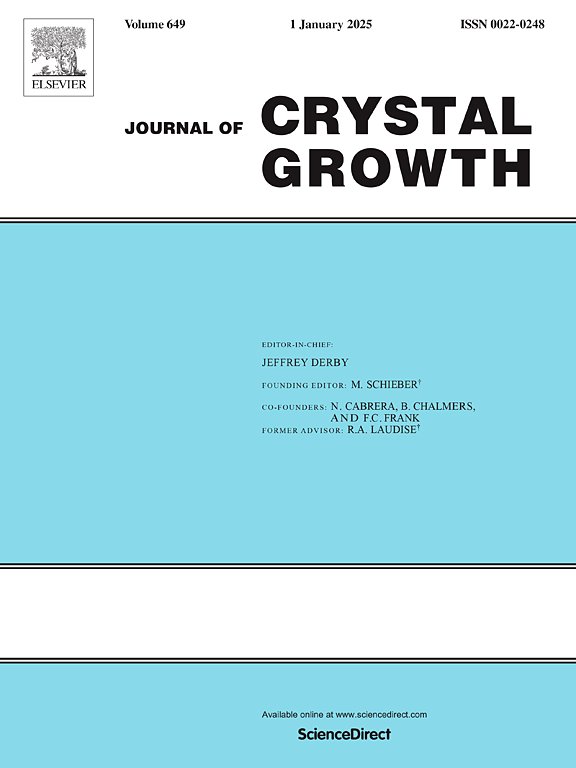Microstructural evolution and crystalline behavior in silicon carbide nano-powder during selective laser melting: A molecular dynamics simulation
IF 1.7
4区 材料科学
Q3 CRYSTALLOGRAPHY
引用次数: 0
Abstract
Silicon carbide (SiC), with its isotropic three-dimensional diamond lattice structure, emerges as a promising candidate for SiC device production through selective laser melting (SLM). The appeal lies in its simplified fabrication process, coupled with outstanding thermal properties, high hardness, and remarkable wear resistance. This potential of SiC in SLM not only streamlines the fabrication process but also harnesses the exceptional properties inherent in SiC. In this study, we utilized molecular dynamics (MD) simulations to model the SLM process. A nanopowder bed made up of approximately half a million atoms of SiC was simulated as a two-layer quasi-2D system. Controlled heating of SiC meltpools, slightly surpassing the melting temperature, facilitated the monitored coalescence of nano-powders, resulting in successful melting and the formation of continuous domains within the meltpools. The observed reduction in crystalline structures is due to the elevated thermal energy imparted to the SiC atoms during the heating process, which disrupts the atomic arrangement and leads to a transition from crystalline to amorphous states. The subsequent solidification process, characterized by a high cooling rate, led to the establishment of final amorphous solidified domains. Looking ahead, our research aims to delve into exploring the structural and functional characteristics of the produced SiC devices, evaluating their potential applications across diverse technological domains.
选择性激光熔化过程中碳化硅纳米粉体的微结构演变和结晶行为:分子动力学模拟
碳化硅(SiC)具有各向同性的三维金刚石晶格结构,是通过选择性激光熔融(SLM)生产碳化硅器件的理想候选材料。其吸引力在于简化的制造工艺,以及出色的热性能、高硬度和显著的耐磨性。碳化硅在 SLM 中的这种潜力不仅简化了制造工艺,而且还利用了碳化硅固有的优异特性。在本研究中,我们利用分子动力学(MD)模拟对 SLM 过程进行建模。由大约 50 万个 SiC 原子组成的纳米粉体床被模拟为一个双层准二维系统。受控加热碳化硅熔池,使其温度略高于熔化温度,促进了纳米粉体的监控凝聚,从而成功熔化并在熔池中形成连续的畴。所观察到的晶体结构减少是由于在加热过程中向碳化硅原子传递的热能升高,破坏了原子排列,导致从晶体态过渡到非晶态。随后的凝固过程以高冷却速度为特征,导致最终非晶凝固域的形成。展望未来,我们的研究旨在深入探索所生产的碳化硅器件的结构和功能特性,评估其在不同技术领域的潜在应用。
本文章由计算机程序翻译,如有差异,请以英文原文为准。
求助全文
约1分钟内获得全文
求助全文
来源期刊

Journal of Crystal Growth
化学-晶体学
CiteScore
3.60
自引率
11.10%
发文量
373
审稿时长
65 days
期刊介绍:
The journal offers a common reference and publication source for workers engaged in research on the experimental and theoretical aspects of crystal growth and its applications, e.g. in devices. Experimental and theoretical contributions are published in the following fields: theory of nucleation and growth, molecular kinetics and transport phenomena, crystallization in viscous media such as polymers and glasses; crystal growth of metals, minerals, semiconductors, superconductors, magnetics, inorganic, organic and biological substances in bulk or as thin films; molecular beam epitaxy, chemical vapor deposition, growth of III-V and II-VI and other semiconductors; characterization of single crystals by physical and chemical methods; apparatus, instrumentation and techniques for crystal growth, and purification methods; multilayer heterostructures and their characterisation with an emphasis on crystal growth and epitaxial aspects of electronic materials. A special feature of the journal is the periodic inclusion of proceedings of symposia and conferences on relevant aspects of crystal growth.
 求助内容:
求助内容: 应助结果提醒方式:
应助结果提醒方式:


